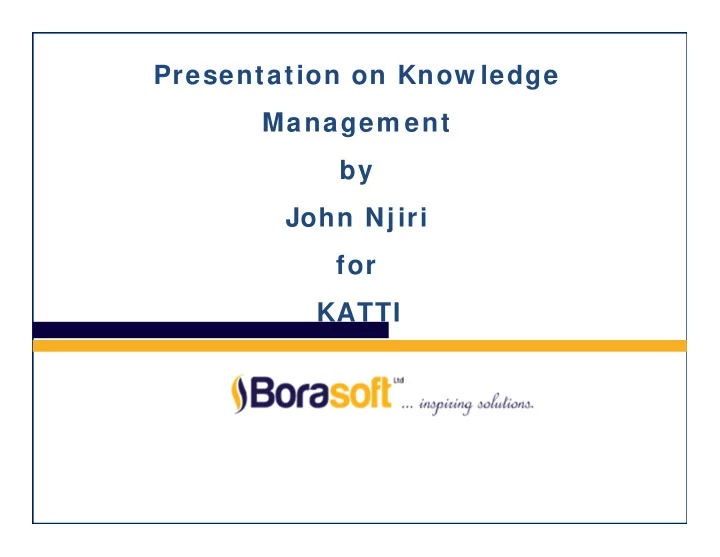

Presentation on Know ledge Managem ent by John Njiri for KATTI
Learning Objectives Introduce delegates to the concept of Knowledge management. Understand Knowledge Management as a PC requirement Give an overview of how to manage Knowledge
Know ledge Managem ent
Knowledge Information, understanding, or skills that you get from experience or education (source: meriam-webster.com Dictionary) • Organizational knowledge is knowledge specific to the organization; it is generally gained by experience. It is information that is used and shared to achieve the organization’s objectives (ISO 9001: 2015)
Organizational Knowledge a) internal sources (e.g. intellectual property; knowledge gained from experience; lessons learned from failures and successful projects; capturing and sharing undocumented knowledge and experience; the results of improvements in processes, products and services); b) external sources ( e.g. standards; academia; conferences; gathering knowledge from customers or external providers).
Knowledge Management KM is a process of acquiring, storing, sharing and transferring expertise accumulated on processes, operations and techniques in order to enhance service delivery
Knowledge Management "Ensuring that workers can carry out their tasks effectively, by providing the right knowledge at the right place at the right time."
Purpose of Knowledge Management? a) safeguarding the organization from loss of knowledge, e.g. — through staff turnover; — failure to capture and share information; b) encouraging the organization to acquire knowledge, e.g. — learning from experience; — mentoring; — benchmarking.
Data and Knowledge management in PC • Identify and document data needs and data gaps under its Mandate; (5% ). • Capture, organize and process data and information in a consistent manner; (5% ). • Establish patterns, trends and attributes of the processed data and information; (10% ). • Draw insights from the data and knowledge intelligence in addressing critical problems to inform on policy and resource allocation; (10% ). • Preserve and share knowledge and lessons learnt across the Institute, sector and Government for continual improvement (10% ).
Data, information & knowledge
Types of knowledge Tacit Know ledge The type of knowledge which people carry in their mind and is therefore difficult to access ~ Michael Polanyi
Types of knowledge Explicit Know ledge The type of knowledge which has been or can be articulated, codified and assorted in the media
Com ponents of KM Knowledge management has four related components / elements/ Enablers 1. Governance 2. People 3.Processes 4.Technology
Governance Three main elements of governance as it applies to Knowledge Management includes: i. Clear corporate expectations ii. Performance management iii. Support
KM Component : People People are the source of knowledge People create and share knowledge
Processes Outlines all aspects involved in the actual management of knowledge. These include: i. Capture/ create ii. Storage iii. Share iv. Transfer v. Utilize/ Use vi. Re-use
Technology • It is through technology that people and processes are supported. • This allows knowledge to be found and accessed wherever it resides • Examples: databases, on the Intranet, in people's heads
Aligning KM with organizational strategy • Is knowledge management an action within your organizational strategy?
Aligning KM with organizational strategy • Organizational strategy is the sum of the actions an organization intends to take to achieve long-term goals. Together, these actions make up a company’s strategic plan.
Aligning KM with organizational strategy Strategy Activities Knowledge
Aligning KM with organizational strategy While aligning KM with organizational strategy: • Identify the activities needed to deliver that strategy • Identify the knowledge needed to deliver the activities • Think how that knowledge can be managed.
Organization culture and KM For knowledge management initiatives to work; • Employees must be willing to share their knowledge. • Leaders should understand their organization’s knowledge culture • Reciprocity for knowledge sharing • Minimal internal competition
KM Documentation KM Framework KM Policy KM Strategy
KM Success Factors Culture: One which is supportive of knowledge management, and the processes I nfrastructure: Support systems, teams, structures, and collaboration. Measures: Developing a process and design for managing change. Technology: Whether technology deserves its status as an enabler is debatable, but it is important.
KM Success factors … Integrating KM into the context of the organization Incorporating means of enforcing managerial responsibility KM approaches should demonstrate how stakeholders benefit from KM Commitment of leadership in KM implementation
KM Failure factors • Lack of performance indicators and measurable benefits • Inadequate management support • Improper planning, design, coordination, and evaluation • Inadequate skill of knowledge managers and workers • Problems with organizational culture • Improper organisational structure • Lack of widespread contribution • Lack of relevance, quality, and usability • Overemphasis on formal learning, systematisation, and determinant needs • Improper implementation of technology • Improper budgeting and excessive costs • Lack of responsibility and ownership • Loss of knowledge from staff defection and retirement
Steps to KM Implementation 1. Educate Top Management 2. Appoint/ assign knowledge management manager/ role/ team 3. Train project team/ champions 4. Awareness training for all employees 5. Undertake a KM assessments and capabilities
Steps to KM I m plem entation 7. Develop the KM Policy/ Strategy 8. Select appropriate technology and non- technology tools to use 9. KM system design, develop and test 10. KM implementation 11. KM evaluation
Thank You
Muthaiga Suites, Opp. Oil Libya Plaza, Off Thika Super Highway P.O. Box: 23158 - 00100 Nairobi, Kenya Tel: +254 (0) 20 2629783/4, 722 507 360, 702 555 222 Email: info@borasoft.co.ke, njirijohn@borasoft.co.ke Website: www.borasoft.co.ke
Recommend
More recommend